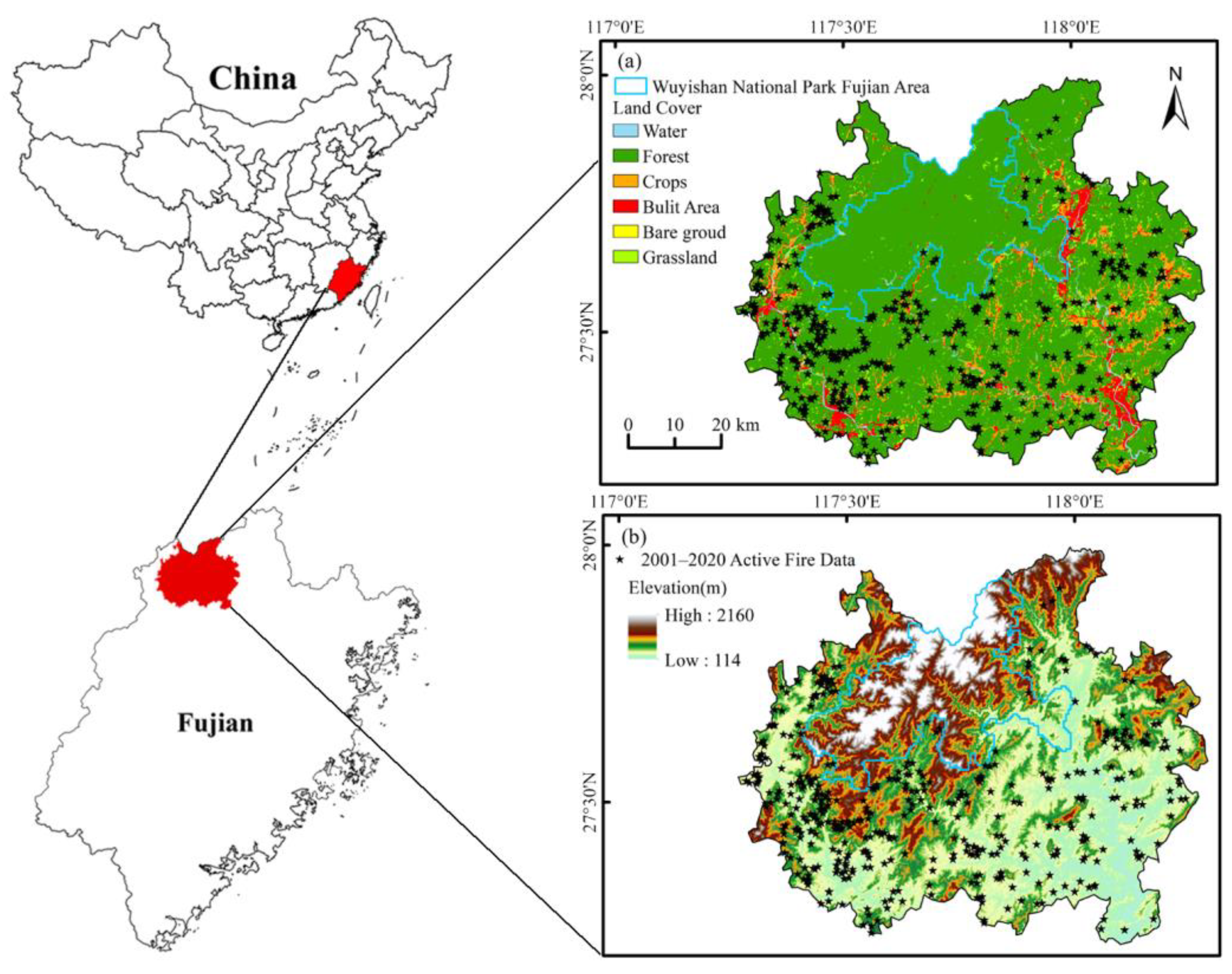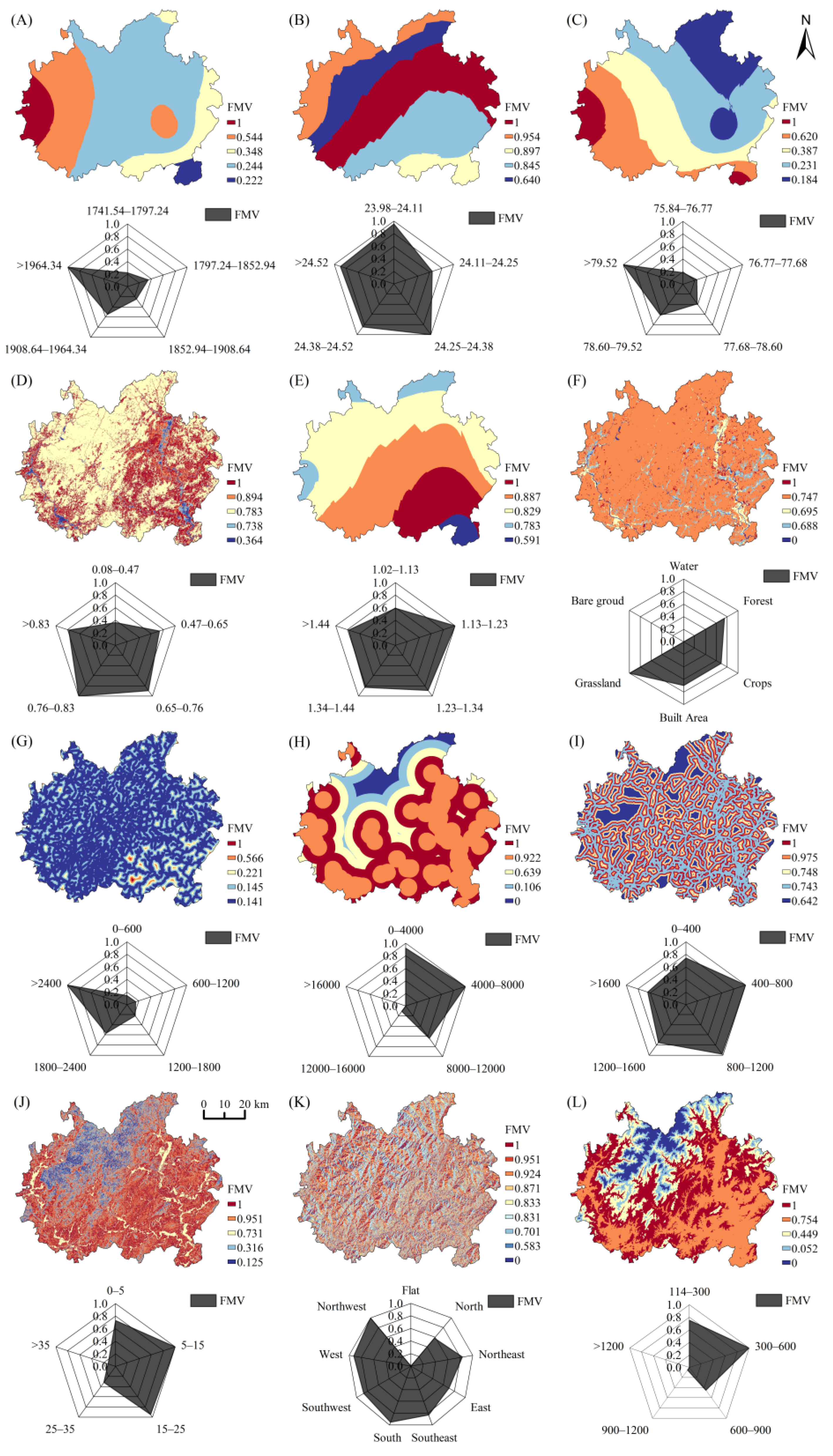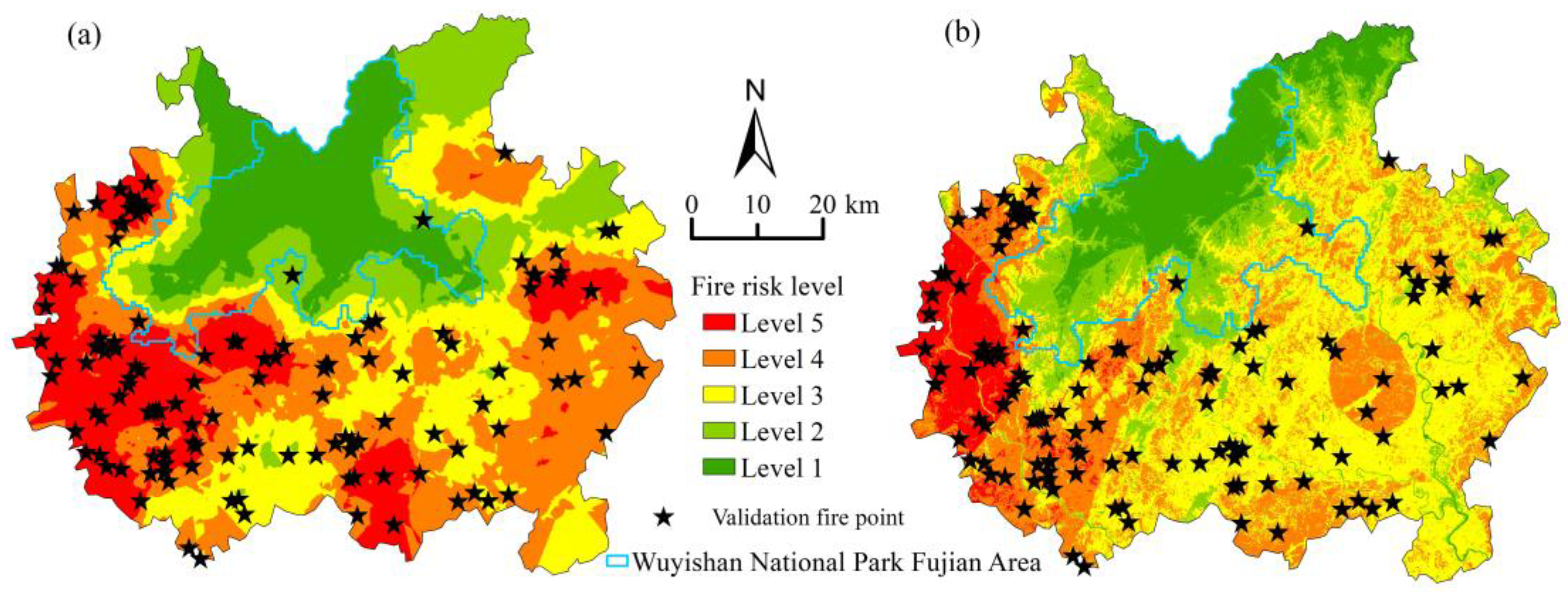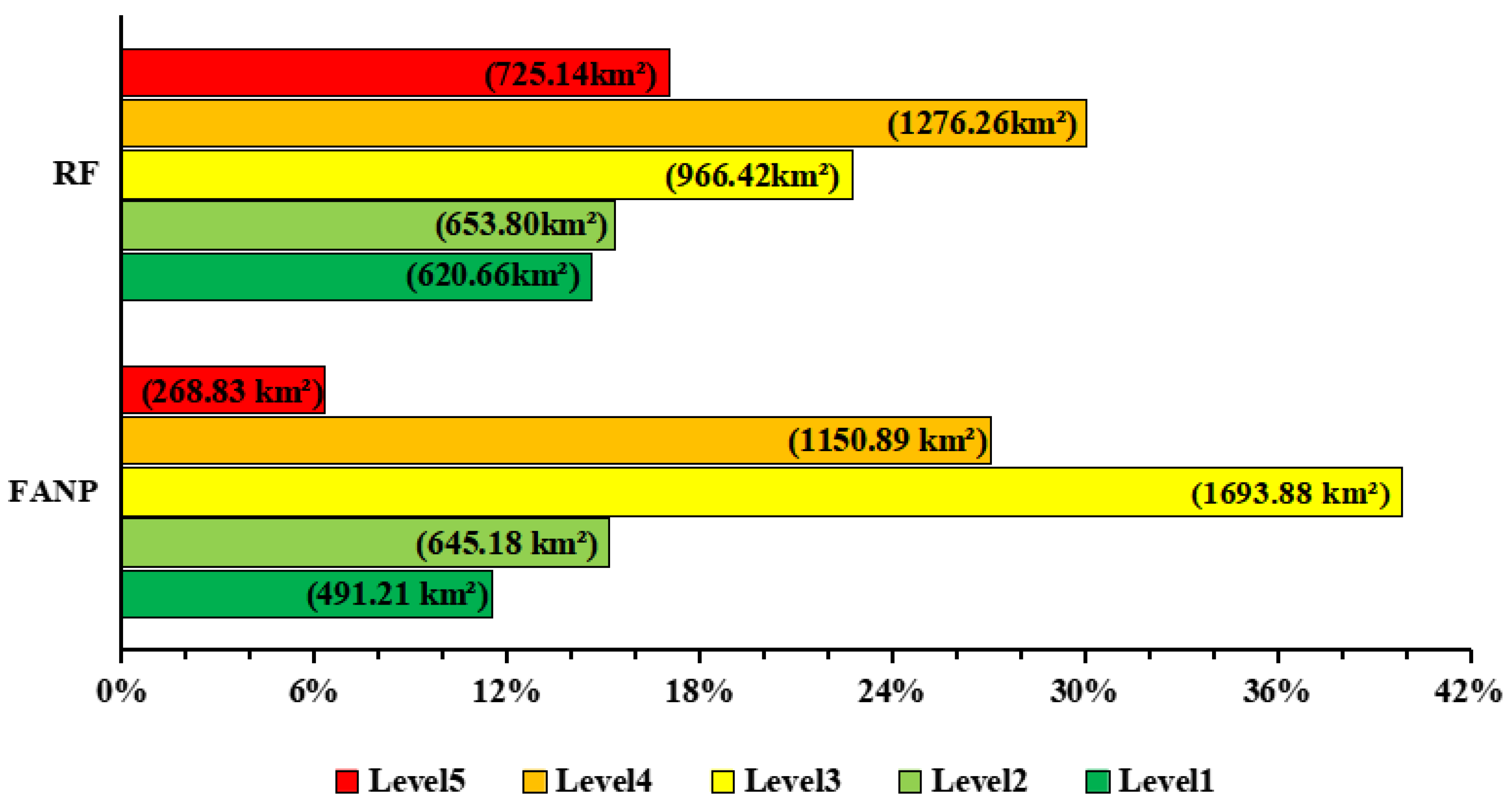Study on Small-Scale Forest Fire Risk Zoning Based on Random Forest and the Fuzzy Analytic Network Process
Abstract
1. Introduction
2. Materials and Methods
2.1. Study Area
2.2. Data Source
2.3. Data Processing
2.4. Methods
2.4.1. Random Forest Algorithm
- Basic principles
- Importance evaluation
2.4.2. Fuzzy Analytic Network Process
- Fuzzy logic
- Analytic Network Process
2.5. Verification of Forest Fire Risk Map
3. Results
3.1. The Grade Weight of Forest Fire Risk Factors
3.2. The Weights of Forest Fire Risk Factors
3.3. Construction of the Forest Fire Risk Map
3.4. Assessment of Forest Fire Risk Map
4. Discussion
5. Conclusions
Author Contributions
Funding
Data Availability Statement
Conflicts of Interest
References
- Crockett, J.L.; Westerling, A.L. Greater temperature and precipitation extremes intensify Western US droughts, wildfire severity, and Sierra Nevada tree mortality. J. Clim. 2018, 31, 341–354. [Google Scholar] [CrossRef]
- Li, X.; Liu, L.; Qi, S. Forest fire hazard during 2000–2016 in Zhejiang province of the typical subtropical region, China. Nat. Hazards 2018, 94, 975–977. [Google Scholar] [CrossRef]
- Jain, P.; Castellanos-Acuna, D.; Coogan, S.C.P.; Abatzoglou, J.T.; Flannigan, M.D. Observed increases in extreme fire weather driven by atmospheric humidity and temperature. Nat. Clim. Change 2022, 12, 63–70. [Google Scholar] [CrossRef]
- Flannigan, M.D.; Krawchuk, M.A.; de Groot, W.J.; Wotton, B.M.; Gowman, L.M. Implications of changing climate for global wildland fire. Int. J. Wildland Fire 2009, 18, 483–507. [Google Scholar] [CrossRef]
- Shu, Y.; Shi, C.; Yi, B.; Zhao, P.; Guan, L.; Zhou, M. Influence of climatic factors on lightning fires in the primeval forest region of the Northern Daxing’an Mountains, China. Sustainability 2022, 14, 5462. [Google Scholar] [CrossRef]
- Tan, C.; Feng, Z. Mapping forest fire risk zones using machine learning algorithms in Hunan province, China. Sustainability 2023, 15, 6292. [Google Scholar] [CrossRef]
- Gigovic, L.; Pourghasemi, H.R.; Drobnjak, S.; Bai, S.B. Testing a new ensemble model based on SVM and random forest in forest fire susceptibility assessment and its mapping in Serbia’s Tara National Park. Forests 2019, 10, 408. [Google Scholar] [CrossRef]
- Eslami, R.; Azarnoush, M.; Kialashki, K.; Kazemzadeh, F. GIS-based forest fire susceptibility assessment by random forest, artificial neural network and logistic regression methods. J. Trop. For. Sci. 2021, 33, 173–184. [Google Scholar] [CrossRef]
- Eugenio, F.C.; dos Santos, A.R.; Fiedler, N.C.; Ribeiro, G.A.; da Silva, A.G.; dos Santos, A.B.; Paneto, G.G.; Schettino, V.R. Applying GIS to develop a model for forest fire risk: A case study in Espírito Santo, Brazil. J. Environ. Manag. 2016, 173, 65–71. [Google Scholar] [CrossRef]
- Guo, F.; Su, Z.; Wang, G.; Sun, L.; Lin, F.; Liu, A. Wildfire ignition in the forests of southeast China: Identifying drivers and spatial distribution to predict wildfire likelihood. Appl. Geogr. 2016, 66, 12–21. [Google Scholar] [CrossRef]
- Jafarzadeh, A.A.; Mahdavi, A.; Jafarzadeh, H. Evaluation of forest fire risk using the Apriori algorithm and fuzzy c-means clustering. J. For. Sci. 2017, 63, 370–380. [Google Scholar] [CrossRef]
- Syafitri, N.; Labellapansa, A.; Kadir, E.A.; Saian, R.; Afini Zahari, N.N.; Anwar, N.H.; Shaharuddin, N.M. Early detection of fire hazard using fuzzy logic approach. Int. J. Adv. Comput. Res. 2019, 9, 252–259. [Google Scholar] [CrossRef]
- Singh, K.R.; Neethu, K.P.; Madhurekaa, K.; Harita, A.; Mohan, P. Parallel SVM model for forest fire prediction. Soft Comput. Lett. 2021, 3, 100014. [Google Scholar] [CrossRef]
- Pham, B.T.; Jaafari, A.; Avand, M.; Al-Ansari, N.; Dinh Du, T.; Yen, H.P.H.; Phong, T.V.; Nguyen, D.H.; Le, H.V.; Mafi-Gholami, D.; et al. Performance Evaluation of Machine Learning Methods for Forest Fire Modeling and Prediction. Symmetry 2020, 12, 1022. [Google Scholar] [CrossRef]
- Abid, F. A Survey of Machine Learning Algorithms Based Forest Fires Prediction and Detection Systems. Fire Technol. 2021, 57, 559–590. [Google Scholar] [CrossRef]
- Milanovic, S.; Marković, N.; Pamucar, D.; Gigović, L.; Kostić, P.; Milanović, S.D. Forest fire probability mapping in eastern Serbia: Logistic regression versus random forest method. Forests 2020, 12, 5. [Google Scholar] [CrossRef]
- Oliveira, S.; Oehler, F.; San-Miguel-Ayanz, J.; Camia, A.; Percira, J. Modeling spatial pattens of fire occurrence in Mediterranean Europe using Multiple Regression and Random Forest. For. Ecol. Manag. 2012, 275, 117–129. [Google Scholar] [CrossRef]
- Breiman, L. Random forests. Mach. Learn. 2001, 45, 5–32. [Google Scholar] [CrossRef]
- Nikolić, G.; Vujović, F.; Golijanin, J.; Šiljeg, A.; Valjarević, A. Modelling of wildfire susceptibility in different climate zones in Montenegro Using GIS-MCDA. Atmosphere 2023, 14, 929. [Google Scholar] [CrossRef]
- Ray, S.K. Flood risk index mapping in data scarce region by considering GIS and MCDA (FRI mapping in data scarce region by considering GIS and MCDA). Environ. Dev. Sustain. 2024, 1–53. [Google Scholar] [CrossRef]
- Ghorbanzadeh, O.; Feizizadeh, B.; Blaschke, T. Multi-criteria risk evaluation by integrating an analytical network process approach into GIS-based sensitivity and uncertainty analyses. Geomat. Nat. Hazards Risk 2018, 9, 127–151. [Google Scholar] [CrossRef]
- Ma, W.; Feng, Z.; Cheng, Z.; Chen, S.; Wang, F. Identifying forest fire driving factors and related impacts in China using random forest algorithm. Forests 2020, 11, 507. [Google Scholar] [CrossRef]
- Jones, M.W.; Abatzoglou, J.T.; Veraverbeke, S.; Andela, N.; Lasslop, G.; Forkel, M.; Smith, A.J.; Burton, C.; Betts, R.A.; van der Werf, G.R.; et al. Global and regional trends and drivers of fire under climate change. Rev. Geophys. 2022, 60, e2020RG000726. [Google Scholar] [CrossRef]
- Şahiner, A.; Ermiş, T.; Karakoyun, M.H.; Awan, M.W. Determining the most effective way of intervention in forest fires with fuzzy logic modeling: The case of Antalya/Türkiye. Nat. Hazards 2023, 116, 2269–2282. [Google Scholar] [CrossRef]
- Güngöroğlu, C. Determination of forest fire risk with fuzzy analytic hierarchy process and its mapping with the application of GIS: The case of Turkey/Çakirlar. Hum. Ecol. Risk Assess. 2017, 23, 388–406. [Google Scholar] [CrossRef]
- Wuyi Mountain National Park Office. Wuyi Mountain National Park (Fujian Area) Introduction. 21 August 2017. Available online: https://wysgjgy.fujian.gov.cn/gygk/gyjj/201708/t20170821_5511563.htm (accessed on 20 November 2014).
- Haixiaziyuanbao. Master Plan for the Protection and Development Belt of Wuyishan National Park (2021–2035). 4 May 2023. Available online: https://zrzyt.fujian.gov.cn/ztzl/ztzlfjmp/202305/t20230505_6163321.htm (accessed on 20 November 2014).
- Cao, Q.; Zhang, L.; Su, Z.; Wang, G.; Sun, S.; Guo, F. Comparing four regression techniques to explore factors governing the number of forest fires in Southeast, China. Geomat. Nat. Hazards Risk 2021, 12, 499–521. [Google Scholar] [CrossRef]
- Guo, F.; Wang, G.; Su, Z.; Liang, H.; Wang, W.; Lin, F.; Liu, A. What drives forest fire in Fujian, China? Evidence from logistic regression and Random Forests. Int. J. Wildland Fire 2016, 25, 505–519. [Google Scholar] [CrossRef]
- Cao, Q.; Zhang, L.; Su, Z.; Wang, G.; Guo, F. Exploring spatially varying relationships between forest fire and environmental factors at different quantile levels. Int. J. Wildland Fire 2020, 29, 486–498. [Google Scholar] [CrossRef]
- Zeng, A.; Yang, S.; Zhu, H.; Tigabu, M.; Su, Z.; Wang, G.; Guo, F. Spatiotemporal dynamics and climate influence of forest fires in Fujian Province, China. Forests 2022, 13, 423. [Google Scholar] [CrossRef]
- Malczewski, J. GIS-based multicriteria decision analysis: A survey of the literature. Int. J. Geogr. Inf. Sci. 2006, 20, 703–726. [Google Scholar] [CrossRef]
- Xiao, F. Forest fire disaster area prediction based on genetic algorithm and support vector machine. Adv. Mater. Res. 2012, 446, 3037–3041. [Google Scholar] [CrossRef]
- Liaw, A.; Wiener, M. Classification and Regression by random Forest. R News 2002, 23, 18–22. Available online: https://www.researchgate.net/publication/228451484 (accessed on 6 January 2025).
- Saaty, T.L. Decision Making with Dependence and Feedback: The Analytic Network Process; RWS Publications: Pittsburgh, PA, USA, 1996. [Google Scholar]
- Nachappa, T.G.; Piralilou, S.T.; Gholamnia, K.; Ghorbanzadeh, O.; Rahmati, O.; Blaschke, T. Flood susceptibility mapping with machine learning, multi-criteria decision analysis and ensemble using Dempster Shafer Theory. J. Hydrol. 2020, 590, 125275. [Google Scholar] [CrossRef]
- Gheshlaghi, H.A.; Feizizadeh, B.; Blaschke, T. GIS-based forest fire risk mapping using the analytical network process and fuzzy logic. J. Environ. Plan. Manag. 2020, 63, 481–499. [Google Scholar] [CrossRef]
- Noroozi, F.; Ghanbarian, G.; Safaeian, R.; Pourghasemi, H.R. Forest fire mapping: A comparison between GIS-based random forest and Bayesian models. Nat. Hazards 2024, 120, 6569–6592. [Google Scholar] [CrossRef]
- Sulova, A.; Jokar Arsanjani, J. Exploratory Analysis of Driving Force of Wildfires in Australia: An Application of Machine Learning within Google Earth Engine. Remote Sens. 2021, 13, 10. [Google Scholar] [CrossRef]
- Makowski, D. Simple random forest classification algorithms for predicting occurrences and sizes of wildfires. Extremes 2023, 26, 331–338. [Google Scholar] [CrossRef]
- Feizizadeh, B.; Omarzadeh, D.; Mohammadnejad, V.; Sharifi, H.A.; Karkarg, B.G. An integratedapproach of artificial intelligence and geoinformation techniques applied to forest fire riskmodeling in Gachsaran, Iran. J. Environ. Plan. Manag. 2022, 66, 1369–1391. [Google Scholar] [CrossRef]
- Sivrikaya, F.; Günlü, A.; Küçük, Ö.; Ürker, O. Forest fire risk mapping with Landsat 8 OLI images: Evaluation of the potential use of vegetation indices. Ecol. Inform. 2024, 79, 102461. [Google Scholar] [CrossRef]
- Lan, Z.G.; Su, Z.W.; Guo, M.; Alvarado, E.C.; Guo, F.; Hu, H.; Wang, G. Are climate factors driving the contemporary wildfire occurrence in China? Forests 2021, 12, 392. [Google Scholar] [CrossRef]
- Guo, F.T.; Su, Z.W.; Wang, G.Y.; Sun, L.; Tigabu, M.; Yang, X.; Hu, H. Understanding fire drivers and relative impacts in different Chinese forest ecosystems. Sci. Total Environ. 2017, 605, 411–425. [Google Scholar] [CrossRef] [PubMed]
- Liu, C.; Lin, M.; Qi, X.; Zheng, W. Estimating the preservation value of Wuyishan National Park from the perspective of bounded rational decision making. Sustainability 2021, 13, 6983. [Google Scholar] [CrossRef]
- Wuyi Mountain National Park Office. Wuyi Mountain National Parkforest Fire Station Established. 22 March 2024. Available online: https://wysgjgy.fujian.gov.cn/zwgk/stbh/202403/t20240322_6418178.htm (accessed on 20 November 2014).
- General Office of Fujian Provincial People’s Government. Notice of General Office of Fujian Provincial People’s Government on Issuing and Distributing Fujian Province Forest Fire Emergency Plan. 24 April 2022. Available online: https://www.fj.gov.cn/zwgk/zxwj/szfbgtwj/202205/t20220510_5906609.htm (accessed on 20 November 2014).




| Data Category Name | Data Source | Data Format | Resolution | Range |
|---|---|---|---|---|
| Rainfall | Geographic remote sensing ecological network platform (http://www.gisrs.cn/ accessed on 11 June 2024) | SHP | 10 m | 2001–2020 |
| Max temperature | SHP | 10 m | 2001–2020 | |
| Wind | SHP | 10 m | 2001–2020 | |
| Relative humidity | SHP | 10 m | 2001–2020 | |
| NDVI | TIF | 30 m | 2001–2020 | |
| Land cover | Esri Land Cover (https://livingatlas.arcgis.com/ accessed on 18 May 2024) | TIF | 10 m | 2023 |
| River | National Catalogue Service For Geographic Information (https://www.webmap.cn/ accessed on 20 July 2023) | SHP | 1:250,000 | 2017 |
| Road | SHP | 1:250,000 | 2017 | |
| Settlement | SHP | 1:250,000 | 2017 | |
| Digital elevation model | Earth Data (https://search.asf.alaska.edu/ accessed on 20 July 2023) | TIF | 12.5 m | / |
| Active fire data | MODIS Collection6.1 Dataset (https://firms.modaps.eosdis.nasa.gov/ accessed on 11 March 2024) | SHP | 1000 m | 2001–2020 |
| Burned-area data | MCD64A1.006 MODIS Burned Area Monthly Global (https://ladsweb.modaps.eosdis.nasa.gov/ accessed on 11 March 2024) | SHP | 500 m | 2001–2020 |
| Cluster | Factor | RF Weight | FANP Weight |
|---|---|---|---|
| Environmental factor | Rainfall | 0.1562 | 0.1771 |
| Maximum temperature | 0.1735 | 0.1310 | |
| Relative humidity | 0.1574 | 0.0597 | |
| NDVI | 0.1032 | 0.1094 | |
| Land cover | 0.0130 | 0.1074 | |
| Wind speed | 0.0366 | 0.0830 | |
| Distance to river | 0.0531 | 0.0223 | |
| Human activity factor | Distance to settlement | 0.0915 | 0.0753 |
| Distance to road | 0.0535 | 0.0412 | |
| Terrain factor | Altitude | 0.0414 | 0.1062 |
| Slope | 0.0811 | 0.0288 | |
| Slope aspect | 0.0394 | 0.0586 |
| Validation Index | FANP | RF |
|---|---|---|
| AUC | 0.885 | 0.814 |
| Precision | 0.755 | 0.715 |
| Recall | 0.914 | 0.766 |
| F1 score | 0.827 | 0.74 |
| Fire Risk Level | FANP | RF | ||||
|---|---|---|---|---|---|---|
| Fire Ratio | Area Ratio | Frequency Ratio | Fire Ratio | Area Ratio | Frequency Ratio | |
| Level1 | 0.00% | 11.56% | 0.00 | 0.78% | 14.61% | 0.05 |
| Level2 | 1.56% | 15.18% | 0.10 | 3.91% | 15.39% | 0.25 |
| Level3 | 32.81% | 39.86% | 0.82 | 20.31% | 22.74% | 0.89 |
| Level4 | 46.09% | 27.08% | 1.70 | 30.47% | 30.03% | 1.01 |
| Level5 | 19.53% | 6.33% | 3.09 | 44.53% | 17.06% | 2.61 |
| ≥Level3 | 98.44% | 73.26% | 1.34 | 95.31% | 69.84% | 1.36 |
| ≥Level4 | 65.63% | 33.41% | 1.96 | 75.00% | 47.10% | 1.59 |
Disclaimer/Publisher’s Note: The statements, opinions and data contained in all publications are solely those of the individual author(s) and contributor(s) and not of MDPI and/or the editor(s). MDPI and/or the editor(s) disclaim responsibility for any injury to people or property resulting from any ideas, methods, instructions or products referred to in the content. |
© 2025 by the authors. Licensee MDPI, Basel, Switzerland. This article is an open access article distributed under the terms and conditions of the Creative Commons Attribution (CC BY) license (https://creativecommons.org/licenses/by/4.0/).
Share and Cite
Chen, D.; Zeng, A.; He, Y.; Ouyang, Y.; Li, C.; Tigabu, M.; Wang, W.; Ni, R.; Zhang, J.; Guo, F. Study on Small-Scale Forest Fire Risk Zoning Based on Random Forest and the Fuzzy Analytic Network Process. Forests 2025, 16, 97. https://doi.org/10.3390/f16010097
Chen D, Zeng A, He Y, Ouyang Y, Li C, Tigabu M, Wang W, Ni R, Zhang J, Guo F. Study on Small-Scale Forest Fire Risk Zoning Based on Random Forest and the Fuzzy Analytic Network Process. Forests. 2025; 16(1):97. https://doi.org/10.3390/f16010097
Chicago/Turabian StyleChen, Dai, Aicong Zeng, Yan He, Yiyun Ouyang, Chunhui Li, Mulualem Tigabu, Wenlong Wang, Rongyu Ni, Jinwen Zhang, and Futao Guo. 2025. "Study on Small-Scale Forest Fire Risk Zoning Based on Random Forest and the Fuzzy Analytic Network Process" Forests 16, no. 1: 97. https://doi.org/10.3390/f16010097
APA StyleChen, D., Zeng, A., He, Y., Ouyang, Y., Li, C., Tigabu, M., Wang, W., Ni, R., Zhang, J., & Guo, F. (2025). Study on Small-Scale Forest Fire Risk Zoning Based on Random Forest and the Fuzzy Analytic Network Process. Forests, 16(1), 97. https://doi.org/10.3390/f16010097






